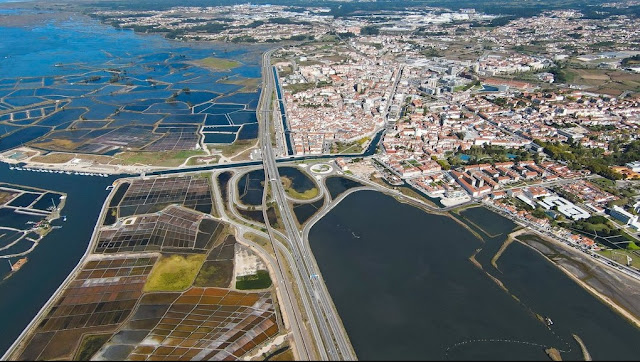The Ria de Aveiro, also known as Foz do Vouga, is a lagoon that exists in the Aveiro region, between Ovar and Mira.
It is a shallow coastal lagoon with extensive intertidal zones, extending into the interior of Portuguese territory, parallel to the Atlantic Ocean, 45 kilometers long and with a maximum width of 11 kilometers. Its area covers two districts (Aveiro and Coimbra) and the towns of Aveiro, Estarreja, Ílhavo, Mira, Murtosa, Ovar and Vagos.
The ria is divided into three channels/zones: the Ovar Channel, the Ílhavo Channel and the Mira Channel.
Characteristics
The ria is the result of the retreat of the sea, with the formation of coastal ridges that, from the 16th century onwards, formed a lagoon that constitutes one of the most important and beautiful geographical features on the Portuguese coast.
In total, the entire mouth covers eleven thousand hectares, of which six thousand are permanently flooded, it unfolds into four important channels branched into streams that surround numerous islands and islets. The Vouga, Antuã, Boco and Fontão rivers flow into it, with the only communication with the sea being a channel that cuts the coastal line between Barra and São Jacinto, allowing access to the port of Aveiro for vessels with deep drafts.
Rich in fish and water birds, it has large areas of water, ideal places for practicing all water sports. Furthermore, even though it has been losing, from year to year, the importance it once had in Aveiro's economy, salt production, using ancient techniques, is still one of the most characteristic traditional activities of the city of Aveiro.
Tributaries
Antuã River
The Antuã River originates at an altitude of approximately 400 meters, in Monte Alto, in the town of Romariz, municipality of Santa Maria da Feira, and extends for approximately 38 kilometers until it flows into the Ria de Aveiro, in the Largo do Laranjo area, municipality of Estarreja. In some places, such as São João da Madeira and Vila de Cucujães, it is known as the Ul river, but in Ul the Antuã river is called the river that effectively bathes S. João da Madeira, Cucujães, S. Tiago de Riba Ul, Oliveira de Azeméis and Estarreja.
Rio Boco
The Boco River originates in the parish of Febres, in the town of Balsas, municipality of Cantanhede. It bathes the municipalities of Vagos and Ílhavo, flowing into the Ria de Aveiro. This watercourse may be called Ribeira or Rio Boco, being known, in times gone by, as Rio Salgado. It is known in the town of Bustos as Vala do Sardão.
Caster River
The Cáster river has its source in the parish of Sanfins, in the municipality of Santa Maria da Feira, crossing several parishes in that municipality and others in the neighboring municipality of Ovar, until it flows into the Ria de Aveiro, which has its northern limit in Carregal. Associated with this river, particularly through fishing and agriculture, have long been residents of Ribeira de Ovar who have depended on its quays — since the mid-18th century — to transport goods between Aveiro, Porto and other lands further inland. interior.
Tourism
The Aveiro ria is widely used for tourist purposes, particularly through its characteristic boats, the moliceiros. Moliceiro boat trips take place on the urban canals of the Ria de Aveiro:
Central Channel; Cojo Channel; Pyramids Channel; São Roque Channel; Canal dos Butirões.
These tours last an estimated 45 minutes and allow you to see the city's main attractions and monuments.



Águeda;
Aguada de Baixo;
Albergaria-a-Velha;
Alvarenga + Paradinha;
Anadia;
Arões + Trebilhadouro;
Arouca + Meitriz;
Arouca Unesco Global Geopark;
Avanca;
AVEIRO;
Bussaco;
Castelo de Paiva;
Cortegaça;
Costa Nova;
Covelo de Paivó + Janarde + Drave;
Curia;
Esmoriz;
Estarreja;
Espinho;
Fábrica da Vista Alegre;
Freita Mountain (Serra da Freita);
Ílhavo;
Mealhada;
Murtosa;
Oliveira de Azeméis;
Oliveira do Bairro;
Ovar;
Palhaça (Aveiro);
Paramos;
Pateira de Fermentelos;
Praia da Barra;
Praia da Vagueira;
Ria de Aveiro;
Salreu;
Sangalhos;
Santa Maria da Feira;
São João da Madeira;
Sever do Vouga;
Silvalde;
Sosa (Vagos);
Vagos;
Vale de Cambra;
Válega;











